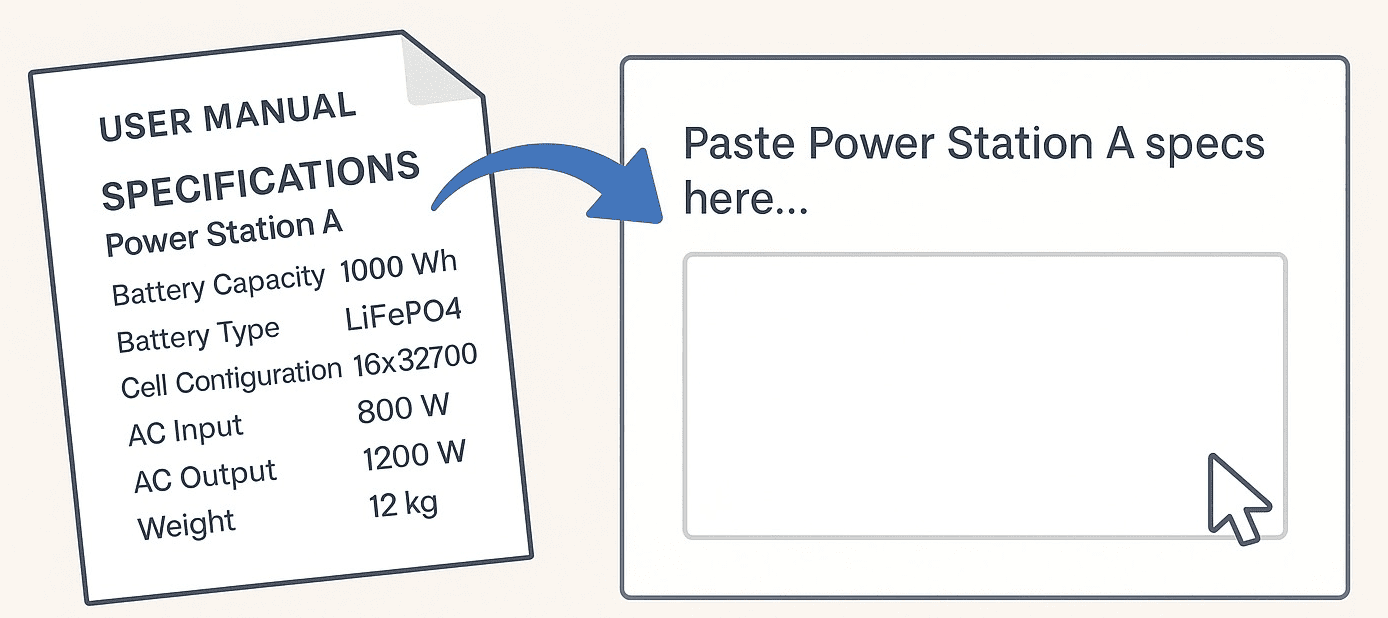
Power Stations DIY Comparison Showdown
Compare two portable power stations to find the best one for camping, emergencies, or off-grid adventures.
Use this tool to compare the specifications of two portable power stations and determine which one best suits your needs. Input product details, paste specification sheets, and review the extracted data in the table below. The tool will analyze key metrics and provide a clear verdict to guide your purchase decision.
Power Stations DIY Comparison Tool
Welcome to the Power Stations DIY Comparison Showdown!
This tool empowers you to compare two portable power stations side-by-side to find the best one for your specific needs, whether for camping, emergency power, or off-grid adventures. By allowing you to input key specifications and providing a clear, point-based verdict, it helps you make an informed purchase decision.
Understanding the Tool:
The Power Stations DIY Comparison Tool guides you through a simple three-step process to compare products effectively:
Step 1: Enter Product Information
Start by providing the names of the two power stations you wish to compare. This helps personalize the comparison results in the final verdict.
Next, select the ‘Source’ of your specifications. We recommend prioritizing sources in this order for data accuracy and ease of use:
- Product Manuals / Official Product Websites: These often provide the most accurate and consistently formatted data.
- Amazon / Other Retailers: While convenient, data from these sources can sometimes be less structured or contain variations.
Step 2: Paste Specifications (Optional for Reference)
You can optionally paste the full product specification sheets into the large text boxes provided. This serves as a handy reference as you manually enter the data into the comparison table.
Important Note on Auto-Filling: While the Power Stations DIY Comparison Tool has a built-in ‘picker’ (using advanced patterns) to attempt to identify and pre-fill some common specifications from your pasted text, it’s designed primarily for manual data entry. Due to the vast and inconsistent formats of product specifications across different manufacturers and retailers, the automatic picker may not find every detail. Always review and manually fill the table.
Need help finding specs? To find detailed specifications, we recommend searching on Google for the product name followed by “user manual” or “specifications PDF” (e.g., “Jackery Explorer 1000 user manual”). This will often lead you to the official product brand’s website where you can download a PDF document. Once you have the PDF, copy *all* the relevant specification text from it and paste it into the boxes below.

Step 3: Review and Edit Comparison Table
Carefully enter or verify the specifications in the interactive comparison table. Pay close attention to the following:
- Mandatory Fields (Highlighted): Fields like ‘Battery Capacity,’ ‘AC Input,’ ‘AC Output,’ ‘Weight,’ and ‘Dimensions’ are highlighted because they are essential for the tool to calculate a comprehensive verdict. If these are missing or invalid, they will be highlighted in red, and the verdict cannot be fully determined.
- Optional Fields: Other fields provide additional context. For a fair comparison, if you fill in a numeric value for an optional spec for one product, please ensure you fill in the corresponding value for the other product. Inconsistent optional fields will also be highlighted in red in the verdict section.
- Unit Selection: For ‘Weight’ and ‘Dimensions,’ remember to select the correct unit (e.g., kg/lbs or cm/in) directly in the table to ensure accurate comparisons.
Final Verdict: How the Winner is Determined
Once you’ve filled in the necessary data, click the ‘Show Final Verdict’ button. The tool evaluates both power stations based on a points system, awarding points for superior performance in key categories:
- Mandatory Fields (2 points each): Battery Capacity, AC Output, AC Input, Weight, Dimensions (volume).
- Optional Fields (1 point each): Solar Input, USB-C Output, USB-A Output, Car Port Output, Solar Charging Time, Car Charging Time, UPS Delay, Typical Runtime, Warranty.
The power station with the higher total score wins. If there’s a tie, the tool will indicate it. The verdict includes a detailed breakdown of which product excels in each category, helping you understand the strengths of each power station.
Enter Product Information
Comparison Table
| Specification | Power Station A | Power Station B | Unit |
|---|---|---|---|
| Power | |||
| Battery Capacity | Wh | ||
| AC Output | W | ||
| AC Input | W | ||
| Solar Input | W | ||
| USB-C Output | W | ||
| USB-A Output | W | ||
| Car Port Output | W | ||
| Physical | |||
| Weight | |||
| Dimensions: Power Station A |
|
||
| Dimensions: Power Station B | |||
| Charging | |||
| Solar Charging Time | hours | ||
| Car Charging Time | hours | ||
| Other | |||
| UPS Delay | ms | ||
| Typical Runtime | hours | ||
| Warranty | years | ||
